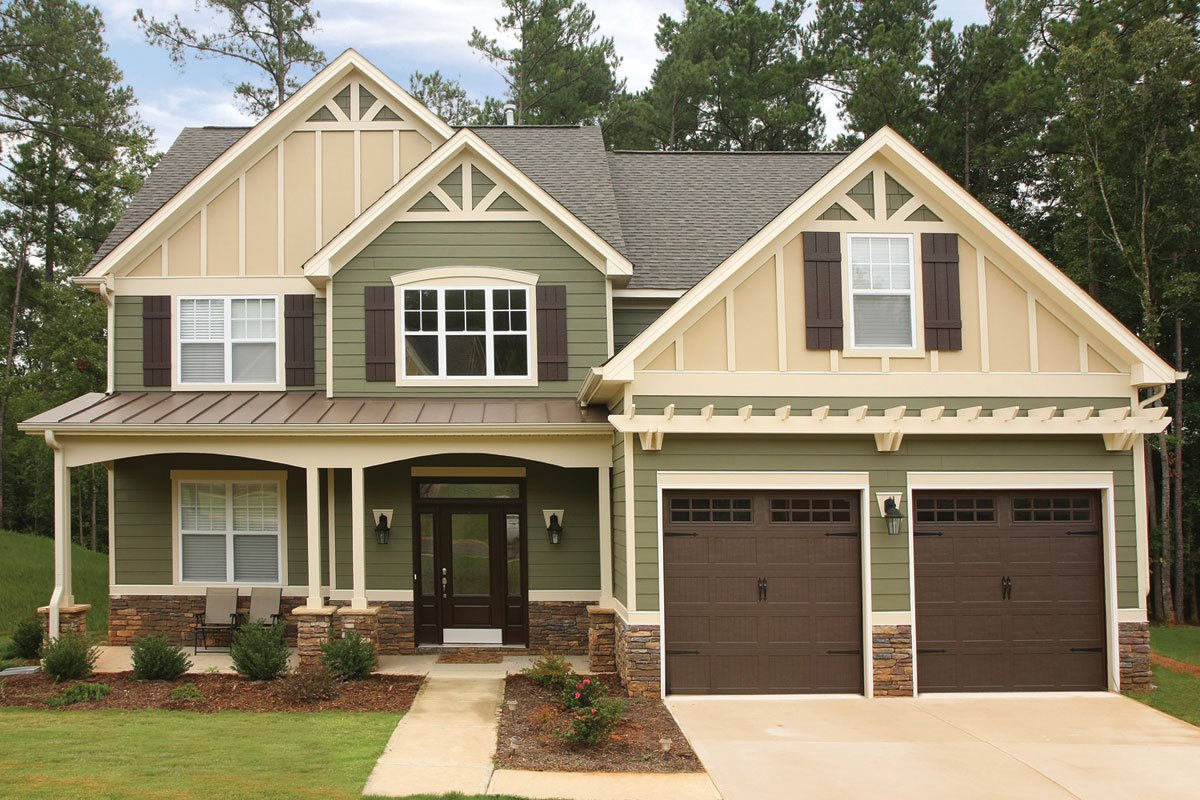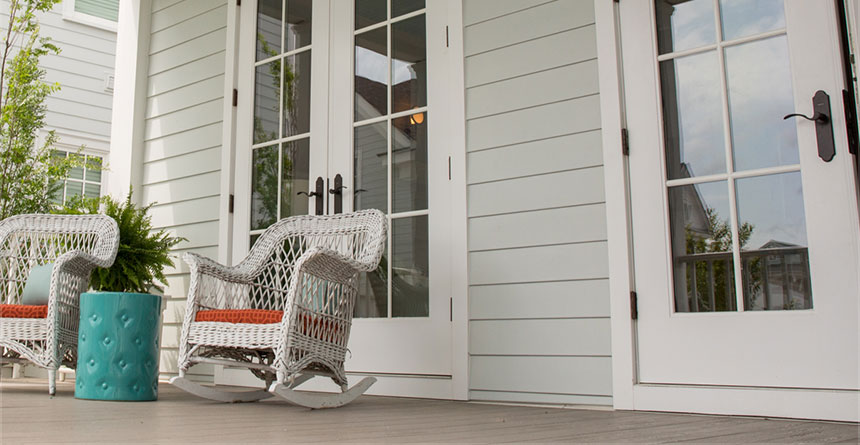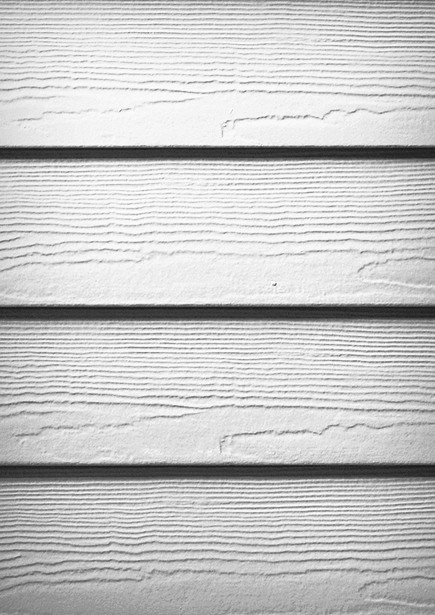Fiber Cement as a siding option continues to be quite a popular choice. A review of U.S. Census data for new single-family houses sold in America shows Fiber Cement garners nearly a quarter of all siding materials.
Brick, Wood and Vinyl are on a downward trend while Fiber Cement continues to gain in popularity. Stucco is, perhaps surprisingly, the #1 siding option in America where its popularity in the Western portion of the U.S. is enormous, but so is Fiber Cement in that region. The two materials combined account for a whopping 92% of the overall residential siding market share out west.
Fiber Cement is commonly referred to as James Hardie, which is the company that originally created this plank board. It’s also called Cement Board, as the materials are made of cement, wood pulp, clay and sand. Fiber Cement is relatively heavy, quite sturdy and will easily last 50 years or longer, while its surface usually needs repainting every 20 to 40 years.
Pricing Information – Part 1
Fiber Cement lap siding costs between $11.50 and $18.50 per sq. ft. installed. Other styles usually exceed $14.50 per sq. ft. installed. When going with the lap siding style, the overall project cost for installing cement board on a typical two-bedroom or three-bedroom American home with approximately 2,000 sq.ft. of siding, will between $23,000 to $37,000, depending on project specifics and your home’s location.
Due to its weight, Fiber Cement routinely requires two workers to install each lap siding piece. For this reason, along with the idea that material waste can add a great expense to the project, the material is not well suited for DIY installations.
There are essentially four styles of Fiber Cement: lap siding is the most common, shake and shingle, vertical panels, and artisan lap, which equals architectural grade of lap siding.
Costing Info – Part 2
As there are numerous factors that can impact the total cost of a project, we will help explain those below, but first let’s break down the costs based on the following example. Note: this is a ballpark estimate example based on the national average cost of materials and job tasks.
Fiber Cement Siding: 2,000 sq. ft. x $12.50 = $25,000 (includes labor)
Additional Building Materials 1: (i.e. J-Channels, corner pieces, corrosion-free fasteners) = $1,500
Additional Building Materials 2: *Optional window trim updates = $4,000
Removal of previous siding: $1,600
Garbage Rental / Disposal Charge: $1,000
Housewrap: $350
Building permit: $400
Total Project Cost = $33,850
The $33,500 is on the high end of our earlier stated range and this is presumably for mid-grade fiber cement material. Which leads to our next section.
Factors Impacting Overall Costs
The first factor to consider is whether previous siding needs to be removed. In many situations where fiber cement is installed, removal of previous siding is needed along with its disposal. While say $2,500 is expensive, the garbage rental fee isn’t cheaper for non-contractors and the labor is fairly intensive for the inexperienced workers.
The type and style of Fiber Cement would be an early consideration. Price would go up between $3.50 and $7.00 per sq. ft. with either differently formed boards or architectural grade material with its superior structural integrity. In our example above, this would add $7,000 to $14,000 to the cost.
The additional materials in the first case are often necessary materials to finish the job. Here you may save hundreds but are likely to spend at least $500 on such items, or it is possible they would just be included in the top line figure.
The second set of additional materials, regarding window trim replacement is best decided during the “obtaining the estimates” phase of the project. In other words, get multiple quotes on the project just as you would with any home improvement project. A professional will tell you if you can keep existing materials on the house and they can restore that or if replacement material is recommended / necessary.
Finally, there is the cost of professional installation, which for Fiber Cement is fairly competitive among contractor given its popularity throughout the U.S. This is another reason to get multiple quotes. A first quote may come in at say $35,000 for everything, and each quote after that averages at $25,000. In such cases where the gap is wide between prices, be sure to ask what additional building materials are included and/or why the overall quote is as high as it is.
The Good, The Bad and The Oh So Pretty
Here we list the pros, cons, and the chief reason for why to consider fiber cement siding.
The Good: Fiber Cement is a very durable, low maintenance siding option. It benefits from being non-flammable, insect resistant material that usually has warranties of around 40 years.
The Bad: Because of how heavy it is, it benefits from professional installation. Like any cement-based product, improper installation can be detrimental where moisture build-up would significantly impact the exterior wall of the home, behind the siding. Fiber Cement is also relatively expensive, but more so when comparing it to Vinyl which is its primary competition.
The Oh So Pretty: Saving the best for last. The ROI for Fiber Cement siding is great, coming in at 84%. And according to the National Association of Realtors’ Remodeling Impact Report, homeowners with Fiber Cement siding claim a top notch 100% Joy Factor when choosing this option.
What are the Best Fiber Cement Siding Brands and How Do they Compare?
Fiber cement siding is a popular building material used for its durability, resistance to weather and pests, and low maintenance requirements. There are several brands of fiber cement siding on the market, each with its own unique features and benefits. Here are some of the best fiber cement siding brands and how they compare:
- James Hardie: James Hardie is one of the most well-known fiber cement siding brands on the market. It is known for its durability, fire resistance, and ability to withstand harsh weather conditions. James Hardie offers a wide range of styles and colors to choose from, and the siding is easy to install.
- Nichiha: Nichiha is a Japanese company that has been producing fiber cement siding for over 60 years. Nichiha’s siding is known for its durability, moisture resistance, and ability to mimic the look of natural materials such as wood and stone. The brand offers a variety of colors and finishes to choose from.
- Allura: Allura is a newer brand of fiber cement siding that has quickly gained popularity. Allura’s siding is known for its strength, resistance to weather and pests, and low maintenance requirements. The brand offers a range of styles and colors to choose from, as well as a 50-year warranty. However, it’s worth noting there has been a successful class action lawsuit against Plycem, the company behind the Allura brand, alleging defective materials were sold.
In terms of how these brands compare, each has its own unique strengths and weaknesses. James Hardie is known for its durability and fire resistance. Nichiha is known for its ability to mimic the look of natural materials, while Allura offers a 50-year warranty and low maintenance requirements. Ultimately, the best fiber cement siding brand for you will depend on your specific needs and preferences.
How Does Fiber Cement Siding Compare to Vinyl and Engineered Wood Siding?
Fiber cement siding, vinyl siding, and engineered wood siding are three popular siding materials used in construction. Each material has its own unique benefits and drawbacks. Here’s how they compare:
- Fiber cement siding: Fiber cement siding is known for its durability and resistance to weather, fire, and pests. It is also low maintenance and can last for many years. Fiber cement siding is heavier than vinyl siding and requires professional installation, but it is also more expensive. Fiber cement siding can mimic the look of wood, stucco, or masonry.
- Vinyl siding: Vinyl siding is a popular choice due to its affordability, low maintenance requirements, and ease of installation. It is lightweight and comes in a wide range of colors and styles. However, vinyl siding is not as durable as fiber cement siding and can crack or fade over time. It is also less fire-resistant and may not withstand extreme weather conditions.
- Engineered wood siding: Engineered wood siding is made from wood fibers and resins, making it more durable and resistant to rot and pests than traditional wood siding. It is also lighter than fiber cement siding and easier to install. Engineered wood siding can mimic the look of natural wood but may require more maintenance than fiber cement siding. It can also be more expensive than vinyl siding.
As you can tell, fiber cement siding is the most durable and resistant to weather and pests, but it is also the most expensive and requires professional installation. Vinyl siding is the most affordable and easy to install but is not as durable as fiber cement siding. Engineered wood siding is more durable than traditional wood siding but may require more maintenance than fiber cement siding. That said, the best siding material for you will depend on your budget, preferences, and the specific needs of your home.
Pros and Cons of Fiber Cement Siding
Fiber cement siding is a popular siding material used in construction. Here are the pros and cons of fiber cement siding:
Pros:
- Durability: Fiber cement siding is known for its durability and resistance to weather, fire, and pests. It can withstand extreme temperatures, high winds, and heavy rain, and it does not rot or warp like wood siding.
- Low Maintenance: Fiber cement siding requires very little maintenance. It does not need to be painted as often as wood siding and can be cleaned easily with a pressure washer or mild detergent.
- Versatility: Fiber cement siding comes in a variety of styles and can mimic the look of wood, stucco, or masonry. It can also be painted to match the color scheme of your home.
- Environmentally Friendly: Fiber cement siding is made from sustainable materials, such as wood pulp and cement, and is recyclable.
Cons:
- Cost: Fiber cement siding is more expensive than vinyl siding and may require professional installation. However, its durability can offset the initial cost.
- Weight: Fiber cement siding is heavier than other siding materials, which can make it more difficult to install. It may require additional support structures to be installed.
- Health Concerns: The dust created during the installation or removal of fiber cement siding can be hazardous if inhaled. Installers should take precautions to avoid breathing in the dust.
- Moisture Issues: Fiber cement siding can absorb moisture, which can lead to cracking and other issues over time. Proper installation and maintenance can prevent this issue.
While, fiber cement siding has many advantages, such as durability, low maintenance, and versatility, it also has some notable drawbacks, such as its higher upfront cost, weight, and health concerns during installation. Homeowners should carefully consider their options and consult with professionals before choosing a siding material.
FAQs
- What is fiber cement siding? Fiber cement siding is a type of siding material made from a mixture of cement, sand, and cellulose fibers. It is known for its durability and resistance to weather, fire, and pests.
- How long does fiber cement siding last? Fiber cement siding can last for many years, with some brands offering warranties of up to 50 years. Proper installation and maintenance can help extend the lifespan of the siding.
- What are the benefits of fiber cement siding? Fiber cement siding is durable, low maintenance, versatile, and environmentally friendly. It can mimic the look of wood, stucco, or masonry and is made from sustainable materials.
- What are the disadvantages of fiber cement siding? Fiber cement siding is more expensive than vinyl siding and can be heavier and more difficult to install. The dust created during installation or removal can be hazardous if inhaled, and moisture can cause cracking and other issues over time.
- How is fiber cement siding installed? Fiber cement siding is typically installed by professionals using specialized tools and techniques. The siding is attached to the home’s exterior with nails or screws and must be properly sealed to prevent moisture intrusion.
- Can fiber cement siding be painted? Yes, fiber cement siding can be painted to match the color scheme of your home. It is recommended to use high-quality exterior paint and to follow the manufacturer’s instructions for application.
- Is fiber cement siding fire-resistant? Yes, fiber cement siding is highly fire-resistant and can help protect your home in the event of a fire. It has a Class A fire rating, which is the highest rating possible.
- Can fiber cement siding be recycled? Yes, fiber cement siding is recyclable and can be crushed and used as a raw material for other products.
- How much does fiber cement siding cost? The cost of fiber cement siding can vary depending on the brand, style, and location. On average, it can cost between $11.50 to $18.50 per square foot to install.
- How do I maintain fiber cement siding? Fiber cement siding requires very little maintenance. It should be cleaned regularly with a pressure washer or mild detergent to remove dirt and debris. Any damaged or cracked pieces should be replaced promptly.
- Can fiber cement siding be used in areas with extreme weather conditions? Yes, fiber cement siding is known for its durability and can withstand extreme weather conditions such as heavy rain, high winds, and extreme temperatures.
- How does fiber cement siding compare to other types of siding materials? Compared to vinyl siding, fiber cement siding is more durable and fire-resistant but is also more expensive. Compared to wood siding, fiber cement siding is more durable and low maintenance but is also heavier and more difficult to install.
- Can fiber cement siding be used on historic homes? Yes, fiber cement siding can be used on historic homes as it can mimic the look of traditional materials like wood clapboard or cedar shingles. It can help preserve the historic look of the home while also providing modern benefits like durability and low maintenance.
- What are some common brands of fiber cement siding? Some common brands of fiber cement siding include James Hardie, Allura, and Nichiha. Each brand may offer different styles and finishes, as well as varying levels of durability and warranties.
- How can I choose the right fiber cement siding for my home? Choosing the right fiber cement siding for your home will depend on a variety of factors, including your budget, style preferences, and the climate in your area. It’s recommended to consult with a professional contractor or siding expert who can help guide you through the selection process and ensure proper installation.


